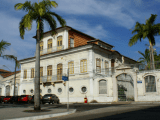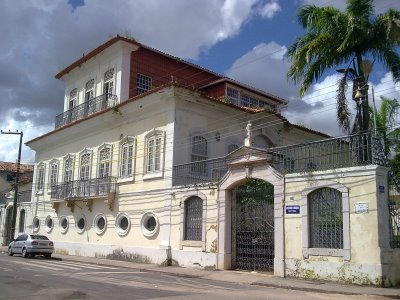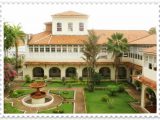Este post também está disponível em:
Português
English

The Cristo Rei Palace is located in Largo dos Amores and has 19th-century Ludoviscan architecture, having served as a home for nobles, Jesuit schools, headquarters of the Archbishopric and currently houses the headquarters of the Federal University of Maranhão (UFMA).
Predominantly neoclassical in style, the palace has a main staircase made of ashlar stones that still retains its original features and is one of the entrances to the interior of the building.
Another attraction is the Cristo Rei Memorial, which houses clothing, a collection of paintings and manuscripts, and devices such as the Remetec, used to communicate and publicise the first entrance exams.
With the title of Guardian of the Memory of UFMA, the Cristo Rei Palace, located in Praça Gonçalves Dias, is a beautiful example of colonial architecture in São Luís. Built in 1838, on the initiative of Commander José Joaquim Vieira Belfort, the mansion served in its early years as his family’s home.
Watch the video Cristo Rei Palace in São Luís do Maranhão

Palácio Cristo Rei
The heirs, however, sold the property in 1900 to the vice-consul of the United States of America, Joaquim Baptista do Prado, a banker who was in the habit of serving sophisticated delicacies to the poor.
After his death by suicide, the mansion was auctioned off, passing through several owners, until it came into the hands of the bishops of São Luís, being the seat of the Archbishopric of the capital, when it received the name “Palácio Cristo Rei”.

.
In the following years, the Archbishopric ceded the building to the Faculty of Philosophy of Maranhão, a course from which the University of Maranhão Foundation originated.
During Josué Montello’s tenure at the head of the rectory, the building is acquired by the institution and undergoes renovations to host the University.
In 1991, a major fire consumed part of the mansion, destroying important university documents, which forced the institution to carry out a major renovation of the Palace, reinaugurating the property on 21 October 1993.
It is on this date that UFMA presents the Cristo Rei Memorial to the public, with the aim of rescuing and preserving the history of the university.
The Memorial’s collection includes documents, official clothing, photographs, old machines used by university courses, such as Remetec, used for communication and publicising the first entrance exams.
There is also a wing for temporary exhibitions.
Cristo ReiThe Cristo Rei Palace was built by architect Manoel Pulgão in the late Baroque style.
The mansion has two floors and a belvedere, with two entrances on the sides, the main one giving access to the garden and the staircase leading to the second floor, decorated with a portal in carved stonework, crowned with a statue of the goddess Diana.
On the ground floor, a set of seven large iron spectacles adorn the façade.
On the upper floor there is a set of three doors with balconies and double lintelled windows on each side. The central set of doors is repeated in the belvedere, whose side walls are covered with colonial tiles.
From there you have a beautiful view of the Gonçalves Dias Square and the São Francisco Bridge over the River Anil.
The garden is one of the highlights of the house. There is a fountain that is probably part of a set of six English pieces from 1856 that came to supply water to São Luís by order of Raimundo Teixeira Mendes, founder of the Companhia de Águas Rio Anil.
There is also a frown on the back walls of the garden, similar to those of the city’s famous fountains.
Palácio Cristo Rei: Praça Gonçalves Dias, 351. Visiting hours: Monday to Friday, from 8am to 11am and from 2pm to 5pm. Free entrance.
Tourism and Travel Guide of São Luís do Maranhão



















